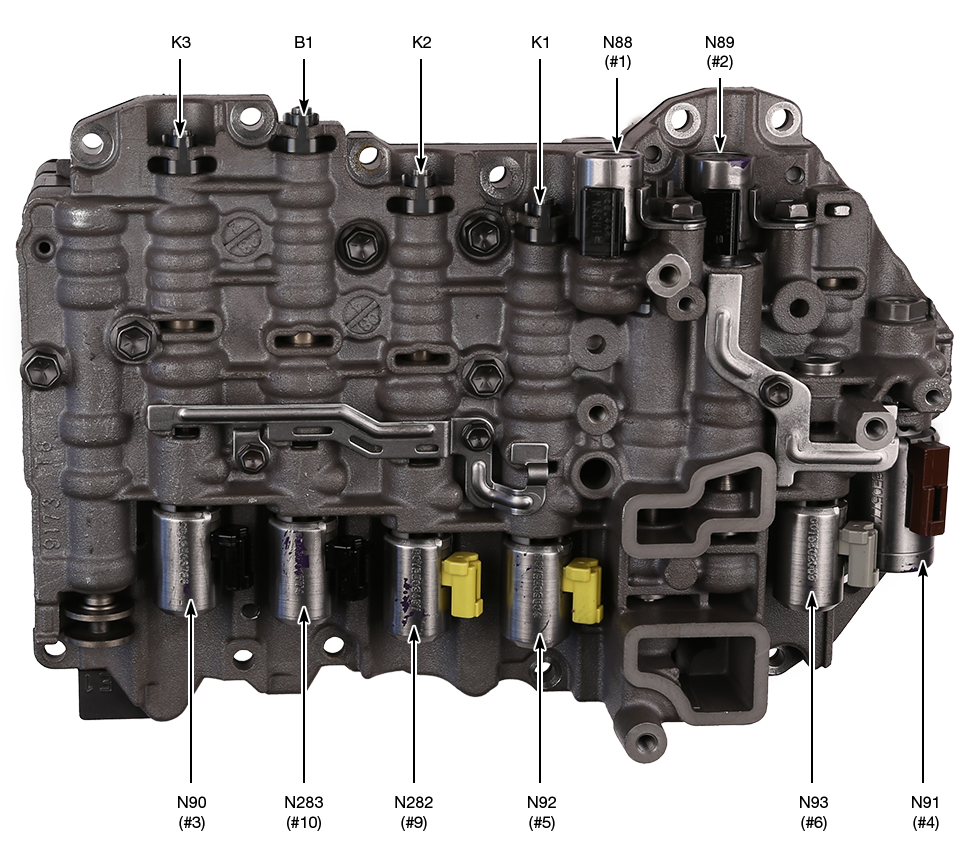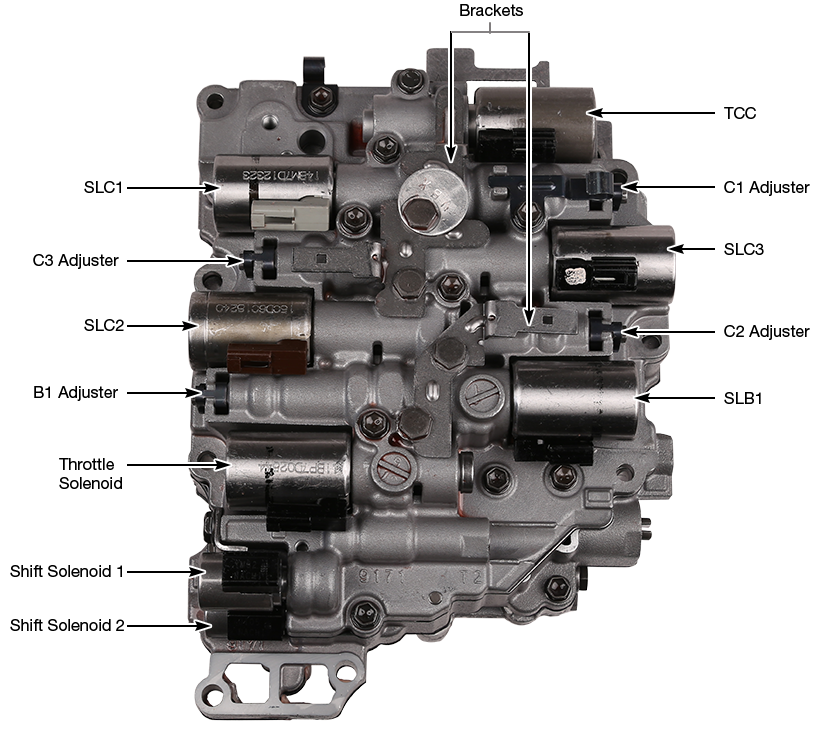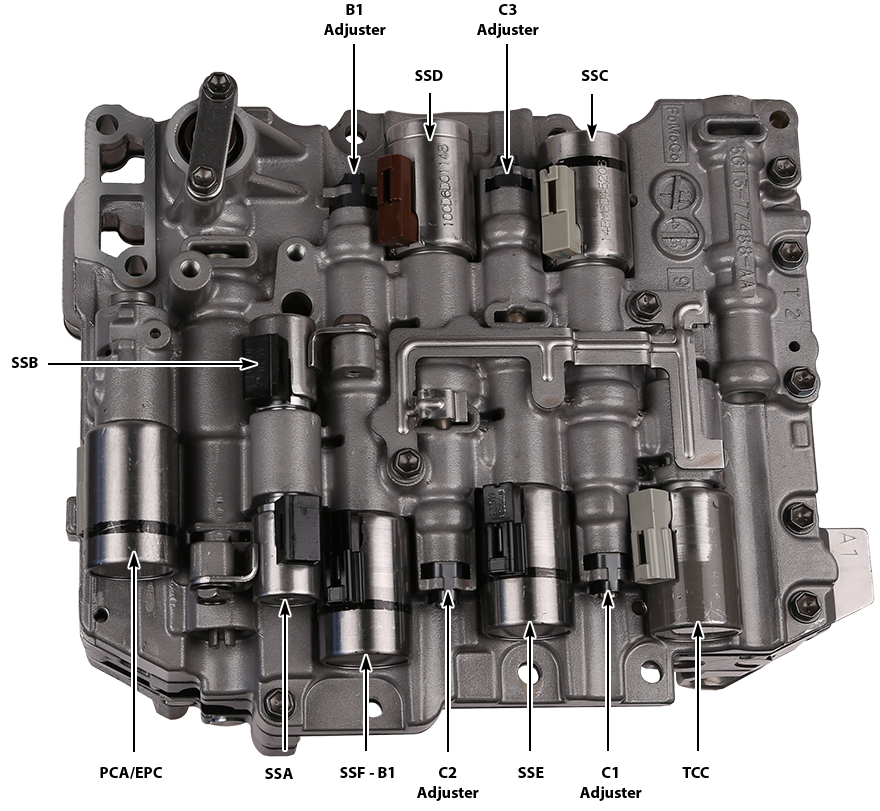Adjusting Clutch Control Valves on Aisin FWD 6-Speeds
Valve Body Xpress
Clutch & Band Application Chart
| VW TF60 | K1 | K2 | K3 | B1 | B2 | F1 |
|---|---|---|---|---|---|---|
| TF80 TF81 | C1 | C2 | C3 | B1 | B2 | F1 |
| Park | - | - | - | - | - | - |
| Reverse | - | - | On | - | On | - |
| Reverse ( >4 mph) | - | - | On | - | - | - |
| Neutral | - | - | - | - | - | - |
| Drive 1st | On | - | - | - | - | On |
| Drive 2nd | On | - | - | On | - | - |
| Drive 3rd | On | - | On | - | - | - |
| Drive 4th | On | On | - | - | - | - |
| Drive 5th | - | On | On | - | - | - |
| Drive 6th | - | On | - | On | - | - |
| Manual Low | On | - | - | - | On | On |
NOTE: The B1 is a band on the TF-81 and clutch on the TF-80 and TF-60.
Solenoid Firing Order Chart
| TF60 | N92 | N282 | N90 | N283 | N88 | N89 | N93 | N91 |
|---|---|---|---|---|---|---|---|---|
| TF80 | SLC1 | SLC2 | SLC3 | SLB1 | SS1 | SS2 | Throttle | TCC |
| TF81 | SSC | SSD | SSE | SSF | SSA | SSB | PCA | TCC |
| Park | On | On | On | On | - | - | * | |
| Reverse | On | On | + Off | On | On | On | * | |
| Neutral | On | On | On | On | - | - | * | |
| Drive 1st | Off | On | On | On | - | - | * | |
| Drive 2nd | Off | On | On | Off | - | - | * | |
| Drive 3rd | Off | On | Off | On | P | P | * | x |
| Drive 4th | Off | Off | On | On | P | P | * | x |
| Drive 5th | On | Off | Off | On | P | P | * | x |
| Drive 6th | On | Off | On | Off | P | P | * | x |
| Manual Low | Off | On | On | On | On | On | * |
- * = Varies with engine load
- x = Capable of lockup in these gears
- + = Reverse inhibited above 4 mph by turning ON
- P = Solenoid on momentarily during the shift
Have you ever installed a TF-80SC, TF-81SC or TF-60SN after overhaul and it has had harsh shifts or engagements, or maybe a flair/bump upshift or harsh coast down clunks? Most times, clearing shift adapts and driving the vehicle to relearn shifts will correct these problems, however, sometimes a shift/engagement issue remains. Assuming there is no excessive wear in the valve body and the linear solenoids are good, the clutch control valves on the valve body can be adjusted to correct these problems.
First let’s get a little background on these valve bodies and clutch control valves. The TF-60SN is also known as an 09G used in Volkswagens and Mini Coopers, the TF-80SC is used in Volvo and GM in the United States and the TF-81SC (also known as AF21) is used in Ford and Mazda vehicles in the United States. TF-60SN, TF-80SN and TF-81SN transmissions have the same solenoid firing order, the same clutch and band application, and all three use clutch control valves and linear solenoids to control the shifts and engagements. They are all adaptive learn transmissions that need to have shift adapts cleared, after which the vehicle must be driven to relearn the shift adapts. Ford, Mazda and Volvo seem to relearn shift adapts quickly, while Volkswagen vehicles seem to take the longest to relearn.
As the clutch and band application chart shows, the four clutches (K1, K2, K3 and B1) control at least one of the shifts or engagements. They use clutch control valves to regulate the engagement of the clutches. For example, the K3 controls the Reverse engagement, 2-3 shift and 4-5 shifts. The linear solenoids that control the clutch control valves are pulsed off to apply the clutch. When the solenoid is electrically off, the solenoid is flowing maximum oil to the clutch control valve.
A clutch control valve line-up consists of a linear solenoid, clutch control valve, spring and adjusters. The solenoid is pulsed off, and it sends oil to the end of the clutch control valve, compressing the spring against the adjuster. As the solenoid pulses, the clutch control valve moves down the the bore and regulates line pressure to the clutch and accumulator. If during pulsing, the valve does not move far enough down the bore, the result will be not enough pressure regulated to the clutch and a flared shift. If the flare is long enough, the TCM will raise line pressure to get the clutch applied and the result will be a flare/bump shift. If the clutch control valve moves too far down the bore during solenoid pulsing, the result will be too much pressure regulated and a harsh shift.
You can see the importance of the proper spring tension on the clutch control valve. If you have a delayed engagement or flare shift you would want to turn the adjuster counterclockwise to decrease spring tension and allow the valve to move a little farther, regulating more pressure to the clutch. For example, say that you have a delay into Reverse and 2-3 flare. You would turn the K3 or C3 adjuster counterclockwise.
There are several reasons why you may need to adjust a clutch control valve:
- Clutch pack clearance may be different than OE. Always check thickness of replacement steels and frictions.
- Bonded pistons may be worn, allowing clutch pressure to leak.
- Sealing rings may not be sealing correctly.
- Slight wear in the valve body.
The most common shift/engagement complaints are:
- Delay/bump into Reverse
- 2-3 Flare/bump and 4-5 flare
- 3-4 Flare bump or 3-4 Neutral
- Harsh 1-2 and sometimes 5-6
The adjustment depends on how severe the problem is:
- Delay into Reverse with a small flare on the 2-3 = K3/C3 turn adjuster counterclockwise 3/4 turn.
- Delay/bump into Reverse, 2-3 flare & 4-5 flare = K3/C3 turn adjuster counterclockwise 1 1/2 turns.
- 3-4 Slight flare = K2/C2 counterclockwise 1 turn.
- 3-4 Flare/bump = K2/C2 counterclockwise 1 1/4 - 1 1/2 turns.
- 3-4 Neutral = K2/C2 counterclockwise 2-2 1/4 turns.
- Firm 1-2 with no flare = B1 clockwise 3/4 - 1 turn.
TF-60SN

TF-80SC

TF-81SC

Related Units
Related Parts
While Sonnax makes every effort to ensure the accuracy of technical articles at time of publication, we assume no liability for inaccuracies or for information which may become outdated or obsolete over time.